

Cara Delevigne and Kate Moss
Then Kate Moss had the bad manners to look over 40 (at the age of 41) and was told by one newspaper that she performed an act of extreme bravery by standing next to Miss Delevigne who was half her age. Dear God, the horror! Look at Kate Moss! It's like Dorian Gray's portrait has escaped the attic and is walking around! Or something. Anyway, there should have been a black border around the piece as it was generally about the sadness that Kate Moss no longer looks like she did twenty years ago. Which leads me to this conversation I had recently with an older friend...

Sylvia Syms, then

Sylvia Syms, now
Apparently it is impossible to watch the lovely Sylvia Syms in any film or tv programme without being overcome with utter misery that she does not look the same as she did in Ice Cold in Alex. Whilst I agree she looks pretty ace shoving the ambulance (was it an ambulance? Why do I think it was an ice cream van?) up the hill in Alex, she looks marvelous now too and is ace in The Queen. It's the same thinking that was expressed to me at a family funeral once where I was trapped in a room with all the other Mrs Walkers of the family and one told me that it would be kinder for women to be shot at 30 as we all look horrible after that. Lawks, I said.
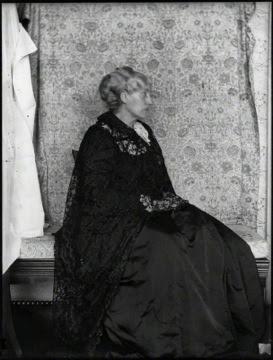
Jane Morris (1898) Emery Walker
All this pop culture, self-obsessed rambling brings me to Pre-Raphaelite stunners. Jane Morris was, until recently, the one stunner who we could see in old age. After Rossetti's death we ceased to see her through the eyes of someone who loved her and saw her through the lens of various cameras. It's not that her photographers didn't like her, but the camera is unable to lie. She poses, she sits, she waits and her stoic expression is recorded. She is almost 60 years old here and her expression is unreadable (as it always is). However, I often hear people express how unhappy Jane looks in her later life.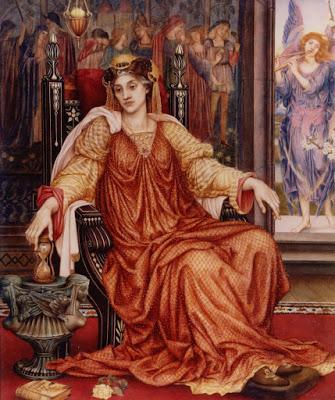
The Hourglass (1905) Evelyn de Morgan
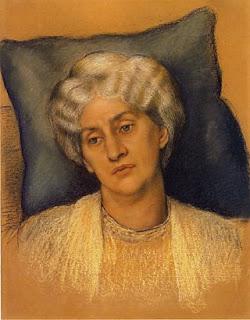
Jane Morris (1904) Evelyn de Morgan
Undoubtedly, Jane Morris does look unhappy in the final painting of her modelling career. When Evelyn de Morgan wanted someone to play the woman who has everything but the ability to stop aging she chose Jane, the aging Stunner. It seems a common assumption, possibly correct, that we read the picture biographically. We ascribe that sadness at a loss of beauty to Jane rather than the character and carry it over to all other images of her. In the photographs of her in old age, sitting in her garden, out and about with her daughters, surrounded by friends: all appear sad to us. Do we have any reason to believe that Jane was so shallow as to allow her changing appearance to overshadow all the blessings she had? From what little I know of Jane I do not believe her to be that shallow, so is it therefore a sadness we impose as viewers upon the faded stunner? Her hair is grey, her face is lined, how unhappy she must be.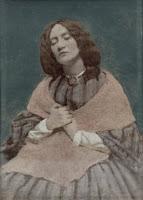
Lizzie, died at 32
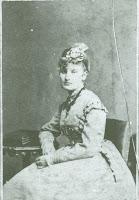
Alexa, died at 37
To use that very unpleasant phrase, we seem to like our Pre-Raphaelite women better if they die young and leave a pretty corpse. The subject matter of the Pre-Raphaelite artists encourages us in this mind-set what with the Ophelias, Elaines and Lady of Shalotts all popping off before they have to use night cream or resort to a box of Nice 'n' Easy. Both Lizzie and Alexa had the good grace not to get old, conveniently dying while still young and pretty. How good of them not to bother us with those inconvenient images of them looking older. We can't cope when people get older. Actually, in our visually orientated, youth obsessed culture we can't cope when we get older and everyone else is collateral damage.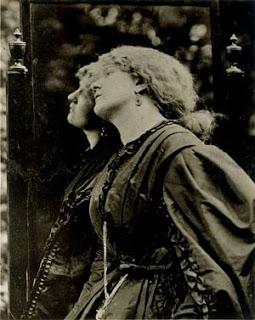
Fanny Cornforth, 1863
Why do we react so badly when people we admire get older? Returning to Sylvia Syms, she was the height of glamour for my older friend, the epitome of what it meant to be attractive when they were both young. Now Sylvia is old that means my friend is old, that she is no longer up to pushing an ambulance or jeep or whatever it was up a hill. Our society says that you might 'look good for your age', but on the whole that's just a nice way of saying 'well done on not looking horrific now that you are over 35. That must help with the sadness, but remember, you are no longer being sexually attractive. Only one woman over 35 is allowed to be sexy and Helen Mirren is doing that.' It's a self fulfilling prophesy - society says women over 35/40/50 aren't sexy so we don't feel sexy so we are declared not sexy and so on. It's such a cycle of sadness and shame and denial that it's impossible to untangle. Woman over a certain age cannot be happy and sexy, so if their fame is based on their attractiveness to the opposite sex then age must render them bereft. All fame now for women is based to some degree or other on our looks so the moment a woman in the public eye starts looking a bit wrinkly, chunky or gray then they must be miserable. We feel miserable for them because through them we vicariously taste glamour, we have a role model for the sexual perfection we can aspire to. All that makes what I am about to do unforgiveable...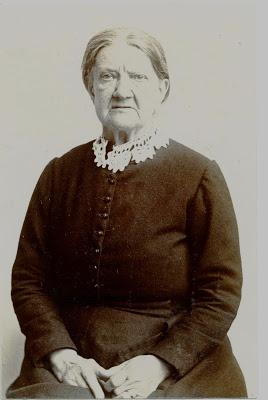
Fanny Cornforth 1907
Many people did not want me to show this picture but now it is in the public domain it is only a matter of time before you see it. The people who have seen this image have told me that they find it devastating, mainly due to the context. This is the photograph taken when Fanny was admitted to Graylingwell Asylum. She looks - I don't know. Well, she doesn't look happy but then she is a Victorian woman posing for a camera. Look at Jane Morris. Smiling wasn't really an option. She looks concerned, her eyebrow on the right is furrowing down. We know she was confused and angry when she was brought to the asylum because she thought she was being arrested. However, we also know that she settled in to life at Graylingwell and it was a comfortable hospital dedicated to caring for and rehabilitating the mentally ill. Was she any happier in 1863, living with her depressed lover, traumatised by the death of his wife whose image haunted their home? She had been ditched by him, forced to marry a drunk, picked back up by her unreliable lover and surrounded by his circle of his friends who did not like her. Yet we don't read sadness into the image of her by the mirror. In 1907 she was approaching the end of her life and everyone she loved was dead, so do we see that? Jane Morris still had her children, a circle of admirers, so why do we read sadness in her image as well. It would be understandable to see Fanny as unhappy in the vulnerability of age, but Jane? Her life was a velvet cushion in comparison.I think the answer lies in the way we see old age and youth. There is little doubt that we are visually obsessed and our focus is on youth, especially for women. I'm sure my gentleman readers (both of you) will correct me if I am wrong but only age for women is seen as a battle we cannot afford to lose. We have so many products for sale that will smooth us, plump us (only our faces sadly, plumpness anywhere else is another source of sadness), recolour what goes gray and generally regenerate us like the Countess Dracula bathing in the blood of virgins. Any opt-out of this unwinnable fight is seen as failure, a tragedy, such terrible sadness. Look at brave Kate Moss stood next to her replacement, no doubt shortly before they take her out the back of the building and put her out of her misery. It would be the kindest thing to do as those tiny wrinkles are making us all very sad.
Don't feel sad for the old stunners. Don't feel sad for Jane, surrounded by comfort, surrounded by those that care. Don't feel sad for Fanny even, cared for finally by people who didn't want anything from her. She lived her life as she chose, in a way that was open to her and considering the options her ancestors gave her, she made a considerable mark on the world. Fanny Cornforth got old, of course she did, and she ended up in a home which is likely to be the fate of many of us reading this. Her home was sympathetic. She lived a long and memorable life to the point that some random woman wrote a book about her a century after she died. That is pretty impressive for a blacksmith's daughter from the back end of nowhere. Don't feel sorry for Fanny, it would do her no good and to be honest I think she would prefer that you thought of her and cheer. Maybe then we wouldn't feel so sad about our own wrinkles and gray hairs.
If you have to feel sorry for anyone, feel sorry for Helen Mirren, she's the only woman over 50 who's allowed to be sexy. The responsibility must be exhausting...

